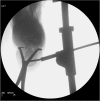Limited Approaches to Calcaneal Fractures
- PMID: 29995196
- PMCID: PMC6105483
- DOI: 10.1007/s12178-018-9511-2
Limited Approaches to Calcaneal Fractures
Abstract
Purpose of review: To review literature published in the last 3 years related to minimally invasive approaches to calcaneal fracture fixation.
Recent findings: Numerous randomized control trials, cohort studies, and meta-analyses have been done in the last 3 years comparing surgical treatment of calcaneus fractures. These studies indicate minimally invasive procedures decrease wound complication rates and achieve similar radiographic and clinical outcomes to open reduction internal fixation. In comparing different surgical treatment methods to non-operative treatment, operative management has increased complication rates but may lead to better functional outcomes in certain patient populations. Optimal treatment for displaced intra-articular calcaneus fractures continues to be debated. Current literature would suggest that the decision to operate be based on patient and fracture characteristics and surgeon capabilities. Minimally invasive techniques aim to improve patient reported outcomes and quality of life while decreasing complications and offer another option for surgeons in the treatment of displaced intra-articular calcaneal fractures.
Keywords: Calcaneus; Intra-articular fracture; Minimally invasive procedure; Percutaneous; Sinus tarsi.
Conflict of interest statement
Conflict of Interest
Emily A. Wagstrom and Jessica M. Downes declare that they have no conflict of interest.
Human and Animal Rights and Informed Consent
All reported studies/experiments with human or animal subjects performed by the authors have been previously published and complied with all applicable ethical standards (including the Helsinki declaration and its amendments, institutional/national research committee standards, and international/national/institutional guidelines).
Figures



References
-
- Bajammal S, Tornetta P, III, Sanders D, Bhandari M. Displaced intra-articular calcaneal fractures. J Orthop Trauma. 2005;19(5):360–364. - PubMed
Publication types
LinkOut - more resources
Full Text Sources
Other Literature Sources
Research Materials

